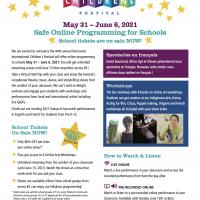"2021 Vancouver International Children's Festival - May 31 to June 13"
Come and join us celebrate the arts with your class! We offer a selection of virtual shows for your preK- Grade 8 students: dance, music, puppetry, story tellings from around the world. 2021 will be the 44th edition of the Festival. We will be virtual this year and give you lots of option to watch the show(s) from the comfort of your classroom for an extended period of time. To simplify your booking this year, we are selling Class Pass(es) at an affordable rate of $60 per class/per show and will allow unlimited streaming from the time the performance is first shown during the week of the Festival (May 31- June 6, 2021) until June 13, 2021. Your class will access a series of six workshops at no additional cost! Come and have fun with us!

We will adhere to the requirements of the BC Health Ministry during the Festival. We hope to be able to offer small groups the opportunity to attend an In-Person show but reserve the right to adjust to an online performance for the safety of our patrons and staff.
Be creative and get your school involved: ask your colleagues to select their favorite show, involve your principal to place a group order and the PAC to financially support your VIrtual Field Trip!






